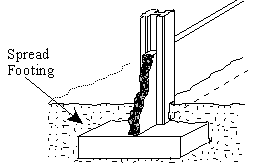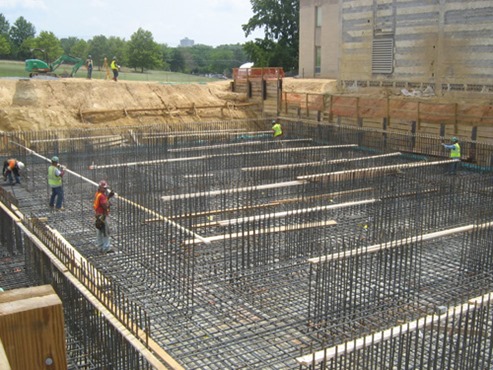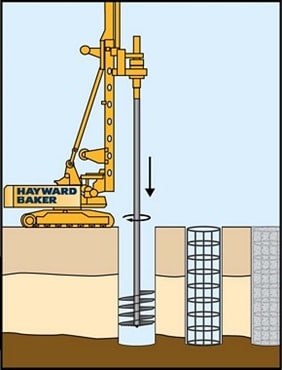Types of Foundation and their Uses.
Types of Foundation and their Uses.
Following are different types of foundations used in construction:
- Shallow foundation
- Individual footing or isolated footing
- Combined footing
- Strip foundation
- Raft or mat foundation
- Deep Foundation
- Pile foundation
- Drilled Shafts or caissons
*Types of Shallow Foundations
Individual Footing or Isolated Footing
Individual footing or an isolated footing is the most common type of foundation used for building construction. This foundation is constructed for single column and also called as pad foundation.
The shape of the individual footing is square or rectangle and is used when loads from the structure are carried by the columns. Size is calculated based on the load on the column and safe bearing capacity of the soil.
The rectangular isolated footing is selected when the foundation experiences moments due to the eccentricity of loads or due to horizontal forces.
For example, Consider a column with a vertical load of 200 kN and safe bearing capacity of 100 kN/m2 then the area of the footing required will be 200/100 = 2m2. So, for a square footing, length and width of footing will be 1.414 m x 1.414 m.
*Combined Footing
A combined footing is constructed when two or more columns are close enough and their isolated footings overlap each other. It is a combination of isolated footings, but their structural design differs.
The shape of this footing is a rectangle and is used when loads from the structure are carried by the columns.
Spread footings or Strip footings and Wall footings
Spread footings are those whose base is wider than a typical load-bearing wall foundations. The wider base of this footing type spreads the weight from the building structure over more area and provides better stability.

Fig: Spread Footing
Spread footings and wall footings are used for individual columns, walls and bridge piers where the bearing soil layer is within 3m (10 feet) from the ground surface. Soil bearing capacity must be sufficient to support the weight of the structure over the base area of the structure.
These should not be used on soils where there is any possibility of ground flow of water above bearing layer of soil which may result in scour or liquefaction.
Raft or Mat Foundations
Raft or mat foundations are the types of foundation which are spread across the entire area of the building to support heavy structural loads from columns and walls.

Fig: Mat Foundation
The use of mat foundation is for columns and walls foundations where the loads from a structure on columns and walls are very high. This is used to prevent differential settlement of individual footings, thus designed as a single mat (or combined footing) of all the load-bearing elements of the structure.
It is suitable for expansive soils whose bearing capacity is less for suitability of spread footings and wall footings. Raft foundation is economical when one-half area of the structure is covered with individual footings and wall footings are provided.
These foundations should not be used where the groundwater table is above the bearing surface of the soil. Use of foundation in such conditions may lead to scour and liquefaction.
Types of Deep Foundation
Pile Foundations
Pile foundation is a type of deep foundation which is used to transfer heavy loads from the structure to a hard rock strata much deep below the ground level.

Fig: Pile Foundation
Pile foundations are used to transfer heavy loads of structures through columns to hard soil strata which is much below ground level where shallow foundations such as spread footings and mat footings cannot be used. This is also used to prevent uplift of structure due to lateral loads such as earthquake and wind forces.
Pile foundations are generally used for soils where soil conditions near the ground surface is not suitable for heavy loads. The depth of hard rock strata may be 5m to 50m (15 feet to 150 feet) deep from the ground surface.
Pile foundation resists the loads from structure by skin friction and by end bearing. Use of pile foundations also prevents differential settlement of foundations.
Drilled Shafts or Caisson Foundation
Drilled shafts, also called as caissons, is a type of deep foundation and has action similar to pile foundations discussed above, but are high capacity cast-in-situ foundations. It resists loads from structure through shaft resistance, toe resistance and / or combination of both of these. The construction of drilled shafts or caissons are done using an auger.
Fig: Drilled Shafts or Caisson Foundation (Source: Hayward Baker)
Drilled shafts can transfer column loads larger than pile foundations. It is used where a depth of hard strata below ground level is the location within 10m to 100m (25 feet to 300 feet).
Drilled shafts or caisson foundation is not suitable when deep deposits of soft clays and loose, water-bearing granular soils exists. It is also not suitable for soils where caving formations are difficult to stabilize, soils made up of boulders, artesian aquifer exists.

